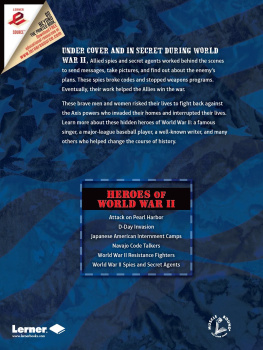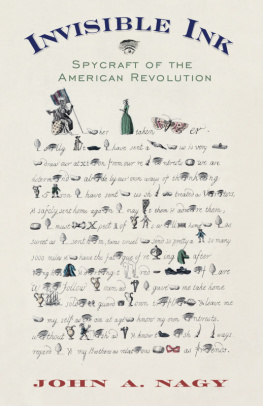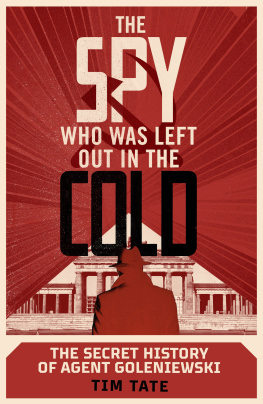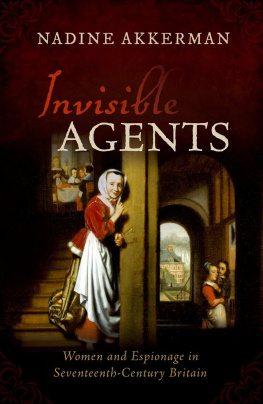Prisoners, Lovers, and Spies
Prisoners, Lovers, & Spies
THE STORY OF INVISIBLE INK FROM HERODOTUS TO AL-QAEDA
KRISTIE MACRAKIS

Published with assistance from the foundation established in memory of Calvin Chapin of the Class of 1788, Yale College.
Copyright 2014 by Kristie Macrakis.
All rights reserved.
This book may not be reproduced, in whole or in part, including illustrations, in any form (beyond that copying permitted by Sections 107 and 108 of the U.S. Copyright Law and except by reviewers for the public press), without written permission from the publishers.
Yale University Press books may be purchased in quantity for educational, business, or promotional use. For information, please e-mail sales.press@yale.edu (U.S. office) or sales@yaleup.co.uk (U.K. office).
Set in Stempel Garamond and Futura types by Integrated Publishing Solutions. Printed in the United States of America.
Library of Congress Cataloging-in-Publication Data
Macrakis, Kristie.
Prisoners, lovers, and spies : the story of invisible ink from Herodotus to al-Qaeda / Kristie Macrakis.
pages cm
Includes bibliographical references and index.
ISBN 978-0-300-17925-5 (cloth : alk. paper) 1. Writing, InvisibleHistory. 2. Invisible inksHistory. 3. Confidential communicationsHistory. 4. EspionageEquipment and suppliesHistory. I. Title.
Z104.5.M33 2014
652dc23
2013032344
A catalogue record for this book is available from the British Library.
This paper meets the requirements of ANSI/NISO
Z39.48-1992 (Permanence of Paper).
10 9 8 7 6 5 4 3 2 1
For
David Kahn
CONTENTS
PREFACE
This book grew out of my discovery of a top-secret invisible ink formula and method. Never before in the history of espionage had any government spy agency released or published a classified secret-writing formula and method.
It was the summer of 2006, and I was in Berlin. I had been submitting request after request to the Stasi archive for material relating to methods for secret writing, or SW, for my earlier book on methods used by the East German intelligence agency, commonly known as the Stasi. In return, I had been receiving file after file of detailed material on how to apply secret writing to a piece of paper and how to detect secret writing by the Stasis mortal enemies, the CIA and the BND (West German Intelligence Agency), but despite frequent pleas, no secret formula or method for creating an effective secret ink had surfaced from the miles and miles of Stasi files. It was frustrating and disappointing. I was ready to give up.
Then on that summer day, the archivist handed me a thin file hidden underneath a pile of useless files. When I peered inside my mouth dropped open. Right before my eyes I saw a document stamped with the German equivalent of Top Secret, and it had a formula written on the first page. My heart started pumping as if I were a kid who had just stolen a candy bar. My face flushed. I felt alive and awake. After skimming the file I knew enough to gauge its significance. My mind started racing: where would I find a chemist to reproduce the reaction system? I began to transcribe surreptitiously the main two pages of the text. I could not believe the archive would let me make copies of the file or release it once they saw what was in it. After I finished copying the file by hand, I reread it so that everything would sink into my brain. At that point, I didnt know anything about cerium oxalate, the rare earth metal used as the secret-writing substance, but I quickly became familiar with it and the developing chemicals included in the file.
Even though I thought the archivists might have made a mistake, I put an order in to photocopy the whole file, along with a few other ones. I tried to be nonchalant about the request. As I was getting ready to leave the archive for the day, the staff associate, to my great surprise, handed me a copy of the file! As I leaped two steps at a time down the wooden stairs, I could hear my footsteps echo (or were they someone elses?) in the cavernous hall. I waltzed out of the building, looked behind me, saw no one chasing me, and fled the building. I finally had gotten what I was looking for.
The information I obtained would grow in significance when I paired it with the vague and impressionistic information I received about the CIAs methods. Because of a ridiculous secrecy policy, the CIA still refused to declassify World War I secret-ink methods and formulas, let alone modern ones.
When I returned to the United States later that summer, I sought out several chemists at my university to determine whether they would be interested in reproducing the secret-writing formula and method. One of them, my office neighbor, Dr. Ryan Sweeder, enthusiastically agreed, and we experimented, successfully reproduced, and published the secret formula with a couple of students in the lab prep room, later dubbed the Spy Lab by journalists.
By this time I was wondering what else had been written about the subject of secret writing in its hidden or invisible form. The answer was: precious little. While bookshelves groaned under the weight of books on cryptography, the study of codes and ciphers, little had been written about its sister discipline, the history of hidden or covered writing, invisible ink, or the art of secret writing. This dearth of information became a problem when I scheduled a lecture and demonstration on the history of invisible ink for my class on the history of espionage and technology. The day before the planned lecture I wandered into the library and found numerous books on cryptography and cryptology, but not one single book on the history of invisible ink. Although I found a few references scattered in the standard cryptography history books by David Kahn and Simon Singh, from which I could cobble together a thin history, I spent most of the lecture producing simple demonstrations like the classic childhood lemon juice and heat experiment. At that point, I never imagined the rich stories I would find after digging into the dustbin of history.
My curiosity was piqued by the challenge of the hidden history. But it wasnt until years later, after I had completed Seduced by Secrets, and with the encouragement of David Kahn, that I decided to tackle this fascinating but hard-to-track history.
If the term forensic traces historian exists, I became one. The mantra of forensic scientists is every contact leaves a trace. Just as the forensic scientist searches for traces of crime evidence, so too did I begin to search for trace evidence left behind by invisible-ink users and creators to write a nontechnical social and cultural history of invisible secret writing.
The main question animating my quest was: how important was invisible ink? In answering this question I was aided by the fact that British, American, and German archives had recently declassified or released exciting new material about spies and invisible ink from the two world wars and the Cold War that underscored its significance to spy agencies.
This book grew out of that discovery during a summer research trip to Berlin, was researched out of curiosity, and was written because of a need. It is the volume I wish I had found on the shelf.
Prisoners, Lovers, and Spies is a biography of a special kind of secret communication, the invisible kind. It tells the story of the life and times of secret writing from the ancient Greeks to the present day in its social, political, scientific, and cultural contexts; it is bookended on one end with the ancient Greek historian Herodotuss description of wax tablets and on the other end with al-Qaedas hidden messages in digital pornographic movies. In between lie stories of international intrigue, of life and death, of love and war, and of magic and wonder. These tales about the people who used and created this secret communication method illustrate key turning points in its evolution through thousands of years of history. Spies were imprisoned or died, adultery was unmasked, and battles were lost because of faulty or intercepted secret communications, but successful hidden writing helped save lives, win battles, and ensure privacy; at least once, it even changed the course of history.
Next page










